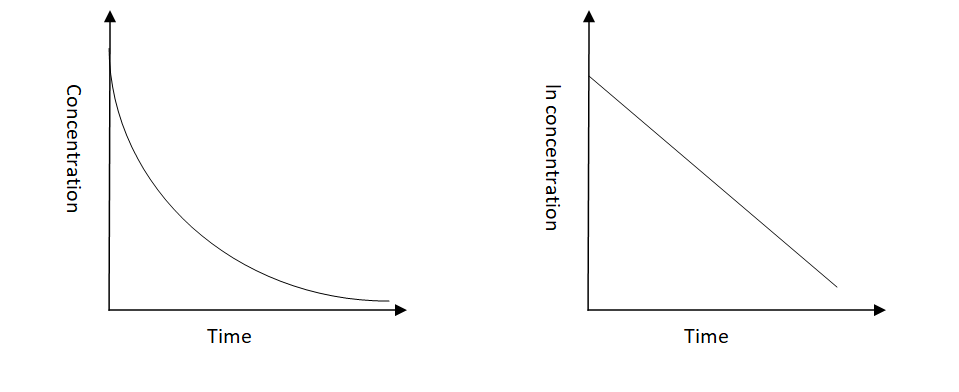
The dissociation of nitrogen pentoxide is a first-order reaction. In the first 24 min, 75% of nitrogen pentoxide is dissociated. What amount of nitrogen pentoxide will be left behind after one hour of the start of the reaction?
(A) Approximately 1 %
(B) Approximately 2 %
(C) Approximately 3 %
(D) None
Answer
555.9k+ views
Hint: A reaction that proceeds at a rate that depends linearly on only one reactant concentration is known as a first-order reaction. Other reactants can also be present in the reaction, but each will have zero order. The rate law and half-life for the first-order reaction are given below-
$-\dfrac{d[A]}{dt}=k[A]\text{; }{{\text{t}}_{1/2}}=\dfrac{\ln (2)}{k}$
Complete Solution:
-Calculating the half-life period of nitrogen pentoxide-
$\therefore {{t}_{1/2}} = \dfrac{24\min }{2}=12\min $
n = number of half-life in 1 hour (60 min) $ = \dfrac{60}{12} = 5$
-Amount of substance left after 5 half-lives-
${{\left( \dfrac{1}{2} \right)}^{5}} = \dfrac{1}{32}$
Therefore, the % of the amount left $=\dfrac{100}{32}=3.125%\approx 3%$
So, the correct answer is “Option C”.
Note: Let us see the derivation of half-life for first-order reactions-
The time taken for the concentration of a given reactant to reach 50% of its initial concentration is known as the half-life of a chemical reaction.
- For the first-order reaction, the rate constant can be mathematically given as –
$k=\dfrac{2.303}{t}\log \dfrac{[{{R}_{0}}]}{[R]}$
- From the definition of half-life,
At $t={{t}_{1/2}}$ and $[R]=\dfrac{[{{R}_{0}}]}{2}$
Substituting the above values in the equation for the first-order rate constant, we will get
$k=\dfrac{2.303}{{{t}_{1/2}}}\log \dfrac{[{{R}_{0}}]}{[{{R}_{0}}]/2}$
- Rearranging the above equation to get the value of ${{t}_{1/2}}$
${{t}_{1/2}}=\dfrac{2.303}{k}\log (2)$
As we know that the value of log(2) is 0.693.
Now, substituting the value of log 2 in the above equation, we will get,
${{t}_{1/2}}=\dfrac{0.693}{k}$
-Let us now see the graphs of the expected shapes of the curves for plots of reactant concentration versus time and the natural logarithm of reactant concentration versus time for a first-order reaction-

-The order for first-order reactions is always equal to 1. Following are some examples of first-order reactions-
(i) $S{{O}_{2}}C{{l}_{2}}\to C{{l}_{2}}+S{{O}_{2}}$
(ii) $2{{N}_{2}}{{O}_{5}}\to {{O}_{2}}+4N{{O}_{2}}$
(iii) $2{{H}_{2}}{{O}_{2}}\to 2{{H}_{2}}O+{{O}_{2}}$
$-\dfrac{d[A]}{dt}=k[A]\text{; }{{\text{t}}_{1/2}}=\dfrac{\ln (2)}{k}$
Complete Solution:
-Calculating the half-life period of nitrogen pentoxide-
$\therefore {{t}_{1/2}} = \dfrac{24\min }{2}=12\min $
n = number of half-life in 1 hour (60 min) $ = \dfrac{60}{12} = 5$
-Amount of substance left after 5 half-lives-
${{\left( \dfrac{1}{2} \right)}^{5}} = \dfrac{1}{32}$
Therefore, the % of the amount left $=\dfrac{100}{32}=3.125%\approx 3%$
So, the correct answer is “Option C”.
Note: Let us see the derivation of half-life for first-order reactions-
The time taken for the concentration of a given reactant to reach 50% of its initial concentration is known as the half-life of a chemical reaction.
- For the first-order reaction, the rate constant can be mathematically given as –
$k=\dfrac{2.303}{t}\log \dfrac{[{{R}_{0}}]}{[R]}$
- From the definition of half-life,
At $t={{t}_{1/2}}$ and $[R]=\dfrac{[{{R}_{0}}]}{2}$
Substituting the above values in the equation for the first-order rate constant, we will get
$k=\dfrac{2.303}{{{t}_{1/2}}}\log \dfrac{[{{R}_{0}}]}{[{{R}_{0}}]/2}$
- Rearranging the above equation to get the value of ${{t}_{1/2}}$
${{t}_{1/2}}=\dfrac{2.303}{k}\log (2)$
As we know that the value of log(2) is 0.693.
Now, substituting the value of log 2 in the above equation, we will get,
${{t}_{1/2}}=\dfrac{0.693}{k}$
-Let us now see the graphs of the expected shapes of the curves for plots of reactant concentration versus time and the natural logarithm of reactant concentration versus time for a first-order reaction-

-The order for first-order reactions is always equal to 1. Following are some examples of first-order reactions-
(i) $S{{O}_{2}}C{{l}_{2}}\to C{{l}_{2}}+S{{O}_{2}}$
(ii) $2{{N}_{2}}{{O}_{5}}\to {{O}_{2}}+4N{{O}_{2}}$
(iii) $2{{H}_{2}}{{O}_{2}}\to 2{{H}_{2}}O+{{O}_{2}}$
Recently Updated Pages
Why are manures considered better than fertilizers class 11 biology CBSE

Find the coordinates of the midpoint of the line segment class 11 maths CBSE

Distinguish between static friction limiting friction class 11 physics CBSE

The Chairman of the constituent Assembly was A Jawaharlal class 11 social science CBSE

The first National Commission on Labour NCL submitted class 11 social science CBSE

Number of all subshell of n + l 7 is A 4 B 5 C 6 D class 11 chemistry CBSE

Trending doubts
Differentiate between an exothermic and an endothermic class 11 chemistry CBSE

10 examples of friction in our daily life

One Metric ton is equal to kg A 10000 B 1000 C 100 class 11 physics CBSE

Difference Between Prokaryotic Cells and Eukaryotic Cells

1 Quintal is equal to a 110 kg b 10 kg c 100kg d 1000 class 11 physics CBSE

State the laws of reflection of light




